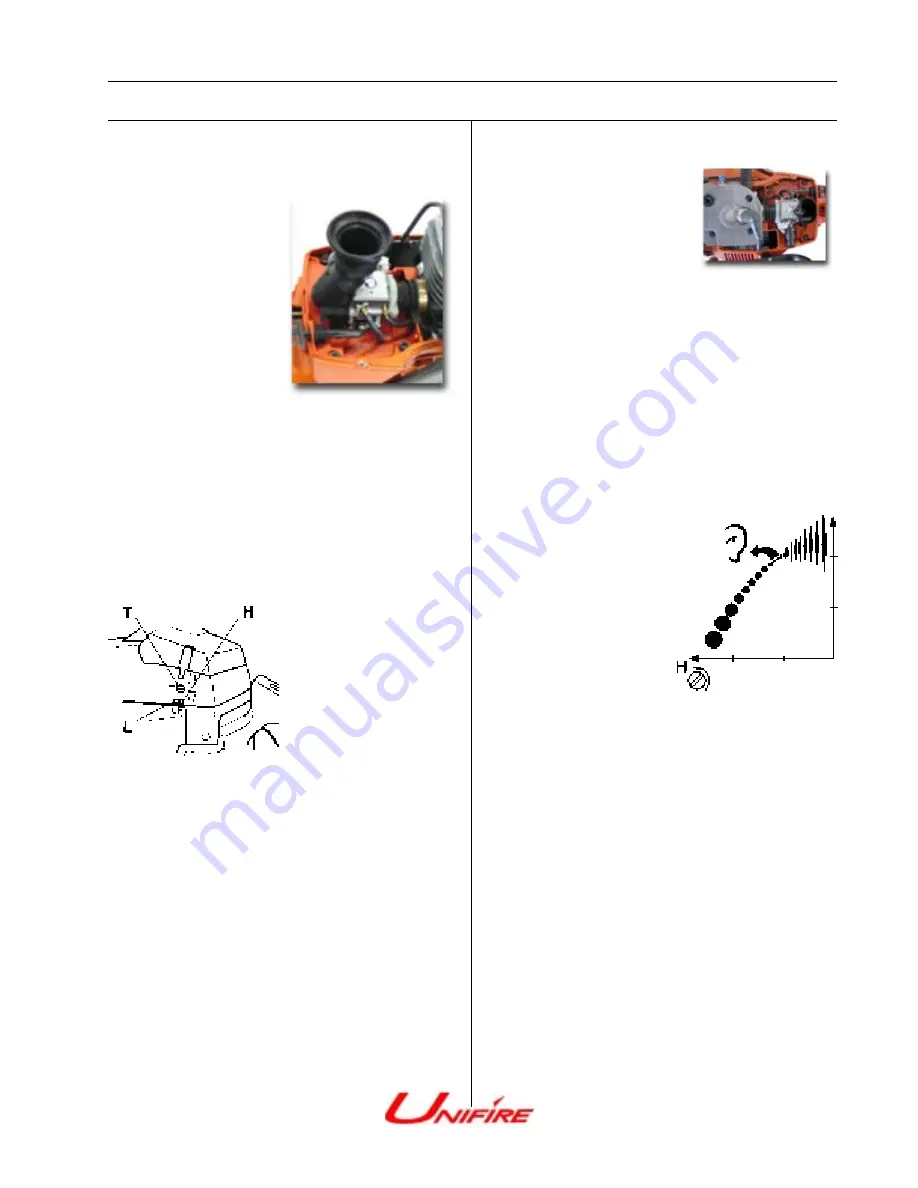
Maintenance
The Unifire Pro-Saw has
been designed and
manufactured to specifi-
cations that reduce
harmful emissions. After
your unit has been run 8-
10 tanks of fuel the engine
has broken in. To ensure
that your unit is at peak
performance and produc-
ing the least amount of
harmful emissions after
break in, adjust your
carburetor for optimum
operating conditions.
When the saw has been “run-in” the carburetor
should be finely adjusted. The fine adjustment
should be carried out by a quailified person. First
adjust the L-jet, then the idling screw T and then the
H-jet.
Low speed needle L
Carburetor
The carburetor has three
adjustment possibilities.
L: Low speed jet
H: High speed jet
T: Adjustment
screw for idling.
High speed needle H
Fine Adjustment
Operation
The carburetor governs the engines speed via the
throttle. Air/fuel are mixed in the carburetor. The air/
fuel mixture is adjustable. To take advantage of the
engines optimal output the setting must be correct.
The setting of the carburetor means that the engine
is adapted to local conditions, for example the
climate, altitude, fuel and the type of 2-stroke oil.
The fuel quantity required in relation to the air flow,
provided by opening the throttle, is adjusted by the L
and H jets. If they are screwed clockwise the air/fuel
ratio becomes leaner (less fuel) and if they are
turned counter clockwise the ratio becomes richer
(more fuel). A leaner mixture gives a higher engine
speed and a richer mixture give a lower engine
speed.
The T screw regulates the idling speed. If the screw
T is turned clockwise this gives a higher idling
speed; counter-clockwise a lower idling speed.
Turn the low speed needle L
clockwise until the stop. If the
engine has bad acceleration or
erratic idling, turn the L needle
counter-clockwise until good
idling and acceleration.
Final setting for the idling speed T
The high speed needle H
influences the power of the
saw. A too lean adjusted high
speed needle H (high speed
needle H closed too much)
gives overrevs and damages
the engine. Turn the high
speed needle H counter
clockwise until the stop. If
the engine runs roughly, turn
the high speed needle slowly
the miniumum amount
clockwise until the engine
runs smoothly.
The high speed needle H is correctly set when the
saw “4-cycles” a little. If the saw “whistles” the setting
is too lean. If there is too much exhaust gas at the
time as the saw ”4-cycles” much, the setting is too
rich. Turn the high speed needle H until the setting
sounds correct. NOTE! For optimum setting of the
carburetor, contact a quailified servicing dealer
who has a revolution counter at his disposal.
Correctly adjusted carburetor
A correctly adjusted carburetor means that the saw
accelerates without hesitation and the saw 4-cycles a
little at max speed. Furthermore, the chain must not
rotate idling. A too lean adjusted low speed needle L
may cause starting difficulties and bad acceleration.
A too lean adjusted high speed needle H gives lower
power-less capacity, bad acceleration and/or dam-
age to the engine. A too rich adjustment of the two
speed needles L and H gives acceleration problems
or too low working speed.
Adjust the idling speed with the screw T. If it is
necessary to re-adjust, first turn the idle speed
adjusting screw T clockwise, until the chain starts to
rotate. Then turn, counter-clockwise until the chain
stops. A correctly adjusted idle speed setting occurs
when the engine runs smoothly in every position. It
should also be good margin to the rpm when the
chain starts to rotate.
Page 6





























